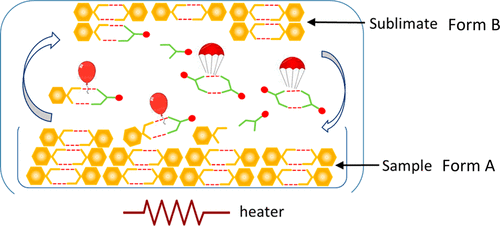当前位置:
X-MOL 学术
›
Cryst. Growth Des.
›
论文详情
Our official English website, www.x-mol.net, welcomes your
feedback! (Note: you will need to create a separate account there.)
Use of Sublimation Catalysis and Polycrystalline Powder Templates for Polymorph Control of Gas Phase Crystallization
Crystal Growth & Design ( IF 3.2 ) Pub Date : 2018-05-08 00:00:00 , DOI: 10.1021/acs.cgd.8b00268 Naghmeh Kamali 1 , Ciaran O’Malley 1 , Mary F. Mahon 2 , Andrea Erxleben 1 , Patrick McArdle 1
Crystal Growth & Design ( IF 3.2 ) Pub Date : 2018-05-08 00:00:00 , DOI: 10.1021/acs.cgd.8b00268 Naghmeh Kamali 1 , Ciaran O’Malley 1 , Mary F. Mahon 2 , Andrea Erxleben 1 , Patrick McArdle 1
Affiliation

|
In pursuit of a solvent-free green alternative to solution-based processes, we have applied the combined use of catalytic additives and polycrystalline powder templates for polymorph control of gas phase crystallization to a range of pharmaceuticals and related compounds. Complementary volatile additives have been found that can catalyze the sublimation of a range of typical active pharmaceutical ingredients (APIs). Sublimation temperatures are typically reduced by up to 20 °C, and the process is accelerated. The use of polycrystalline powder templates for polymorph control has also been successfully applied in several cases. Temperature control at the sites of both sublimation and desublimation is often required. The absence of even traces of solvent in the polymorphs produced appears to give the samples higher stability than samples obtained by crystallization from solution. Complete polymorph control was achieved with the following APIs, carbamazepine (five polymorphs), metaxalone (two polymorphs), mefenamic acid (two polymorphs), paracetamol (two polymorphs), and ortho-, meta-, and para-amino benzoic acids (one, four, and two polymorphs respectively).
中文翻译:

升华催化和多晶粉末模板在气相结晶多晶型控制中的应用
为了寻求无溶剂的绿色替代溶液方法的方法,我们将催化添加剂和多晶粉末模板的组合使用用于气相结晶的多晶型控制,应用于一系列药物和相关化合物。已经发现互补的挥发性添加剂可以催化一系列典型的活性药物成分(API)的升华。通常将升华温度降低多达20°C,并加快了过程。多晶粉末模板用于多晶型物控制的用途也已成功应用于几种情况。经常需要在升华和降华位置进行温度控制。与从溶液中结晶得到的样品相比,在所产生的多晶型物中甚至没有痕量的溶剂似乎使样品具有更高的稳定性。使用以下API可以完全控制多晶型物:卡马西平(五个多晶型物),美沙酮(两个多晶型物),甲芬那酸(两个多晶型物),扑热息痛(两个多晶型物)和邻氨基,间氨基和对氨基苯甲酸(分别为一个,四个和两个多晶型物)。
更新日期:2018-05-08
中文翻译:

升华催化和多晶粉末模板在气相结晶多晶型控制中的应用
为了寻求无溶剂的绿色替代溶液方法的方法,我们将催化添加剂和多晶粉末模板的组合使用用于气相结晶的多晶型控制,应用于一系列药物和相关化合物。已经发现互补的挥发性添加剂可以催化一系列典型的活性药物成分(API)的升华。通常将升华温度降低多达20°C,并加快了过程。多晶粉末模板用于多晶型物控制的用途也已成功应用于几种情况。经常需要在升华和降华位置进行温度控制。与从溶液中结晶得到的样品相比,在所产生的多晶型物中甚至没有痕量的溶剂似乎使样品具有更高的稳定性。使用以下API可以完全控制多晶型物:卡马西平(五个多晶型物),美沙酮(两个多晶型物),甲芬那酸(两个多晶型物),扑热息痛(两个多晶型物)和邻氨基,间氨基和对氨基苯甲酸(分别为一个,四个和两个多晶型物)。











































 京公网安备 11010802027423号
京公网安备 11010802027423号